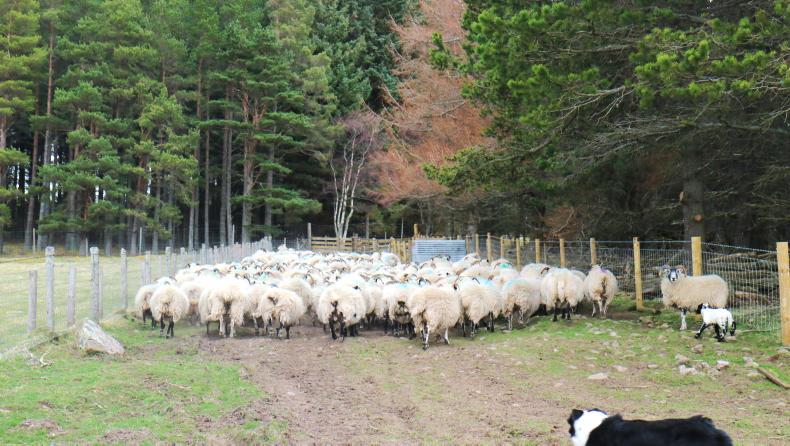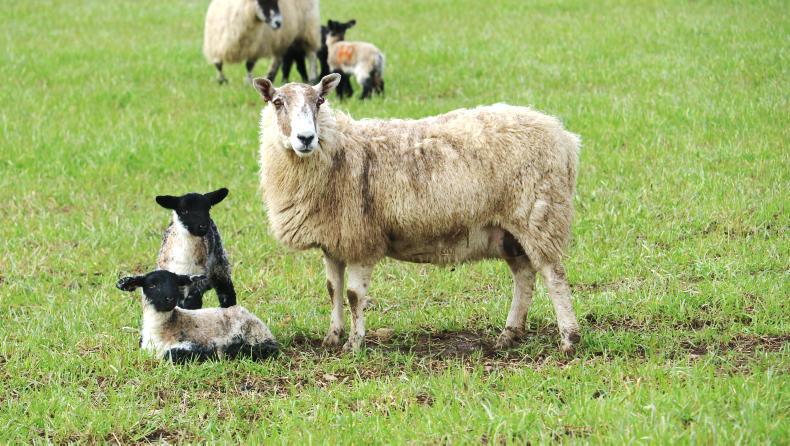With only a couple of stragglers left, Arthur Duguid has hailed this year’s lambing a success. “It’s been good and the weather has been perfect,” he said.
“Since the lambs and ewes have gone out to grass they have just mushroomed. The ewes have been getting some neeps to supplement them but the grass is now taking off.”
Starting with 312 to the tup, they have lost 20 ewes which was mainly before lambing. There were a few prolapses in the run-up to lambing.
The family are happy with their Cheviot ewes in particular
The prolapses were stitched back in which Arthur found to be a successful treatment. This year, they have 14 orphan lambs being bottled-fed which have not been twinned on to ewes.
The family are happy with their Cheviot ewes in particular, which went to the Bluefaced Leicester to make Mule lambs for breeding. All these females have been ear-notched and depending on size they will be put to the tup this year or next.
Grass levels
Grass was restricted before lambing to ensure lambs were the right size for birth. However, the mild spring has made it more difficult to manage grass levels on the farm. This has meant lambs were getting bigger towards the end of lambing.
The Suffolk tup was leaving the biggest lambs and Arthur is concerned that the lamb size is causing a problem. He will be reviewing the use of the Suffolk tup this year to increase lambing ease in 2021.
It was a very quick lambing this year
The current tup breeds used in the flock are Bluefaced Leicester, Charollais, Texel and Suffolk.
Andy and Debbie Duffus have had a quicker lambing this year, with two-thirds of the ewes giving birth in the first 10 days. “It was a very quick lambing this year,” said Andy.

Mule gimmer with newborn lamb at Cranna.
“We decided to tighen things up last year. We had the tups in for only a month when usually we would give the ewes two cycles.” Andy thinks that the good weather in the back end of 2019 meant the ewes were in better condition at tupping time which resulted in a higher conception rate.
Lambing this year started around 12 April and missed the coarse weather.
Andy and Debbie have a 250-ewe Blackface flock which they split into two groups. They put 90 ewes to two Bluefaced Leicester tups. The other 160 ewes went to three Blackface tups and a Texel.

Ewe and twins on the hill at North Cranna.
The farm also lambs 200 Mules which are put to Texel and New Zealand cross Suffolk tups. Andy is happy with the tups’ performance and thinks he has the balance right between easy lambing, vigour and carcase. The Blackfaces scanned 155% and the Mules 178% this year, which is a good scanning for the flock.
They wouldn’t expect to get many cattle out until the end of May
Grass growth starts a bit later for Andy and Debbie as their farm is high in the Scottish Cairngorms. They wouldn’t expect to get many cattle out until the end of May. However, through improved fertility and application of fertiliser a fortnight before lambing, they did have growing grass for the birthing ewes.
The hill on the farm can take some time before there is significant grass growth.

Andy moves his ewes morning and night to separate out those with lambs from the flock.
In some years, little happens until well into June. Night temperatures can still dip below zero regularly, with Andy saying it was minus three degrees Celsius in the cold wind.
Ewes were given draff (distillery byproduct), bruised barley and soya in troughs in the run-up to lambing.
Supplementary feeding has been needed after lambing for the Blackfaces
They also got minerals and a pre-lamber bucket. Neeps were too expensive to buy this year but would be an option when the price is right.
Supplementary feeding has been needed after lambing for the Blackfaces, while the Mules have all gone on to just grass.
Andy said they had the usual few big single lambs which caused some difficulties and a couple of twin lamb disease ewes, but nothing out of the ordinary.
Triplet lambs are twined on to singles or barren ewes
Andy and Debbie move the ewes between the fields on their farm each morning and night, bringing the ewes closer to the farm during the day. This seperates the ewes and lambs from the sheep until they give birth, preventing mismothering.

Lambing and turnout of stock at Duguids.
Triplet lambs are twined on to singles or barren ewes. Andy bought adopters to help encourage a bond between ewes and their adopted lambs. He finds that Mule ewes will take a new lamb very easily, while Blackfaces need a little encouragement in the lamb adopter.
With only a couple of stragglers left, Arthur Duguid has hailed this year’s lambing a success. “It’s been good and the weather has been perfect,” he said.
“Since the lambs and ewes have gone out to grass they have just mushroomed. The ewes have been getting some neeps to supplement them but the grass is now taking off.”
Starting with 312 to the tup, they have lost 20 ewes which was mainly before lambing. There were a few prolapses in the run-up to lambing.
The family are happy with their Cheviot ewes in particular
The prolapses were stitched back in which Arthur found to be a successful treatment. This year, they have 14 orphan lambs being bottled-fed which have not been twinned on to ewes.
The family are happy with their Cheviot ewes in particular, which went to the Bluefaced Leicester to make Mule lambs for breeding. All these females have been ear-notched and depending on size they will be put to the tup this year or next.
Grass levels
Grass was restricted before lambing to ensure lambs were the right size for birth. However, the mild spring has made it more difficult to manage grass levels on the farm. This has meant lambs were getting bigger towards the end of lambing.
The Suffolk tup was leaving the biggest lambs and Arthur is concerned that the lamb size is causing a problem. He will be reviewing the use of the Suffolk tup this year to increase lambing ease in 2021.
It was a very quick lambing this year
The current tup breeds used in the flock are Bluefaced Leicester, Charollais, Texel and Suffolk.
Andy and Debbie Duffus have had a quicker lambing this year, with two-thirds of the ewes giving birth in the first 10 days. “It was a very quick lambing this year,” said Andy.

Mule gimmer with newborn lamb at Cranna.
“We decided to tighen things up last year. We had the tups in for only a month when usually we would give the ewes two cycles.” Andy thinks that the good weather in the back end of 2019 meant the ewes were in better condition at tupping time which resulted in a higher conception rate.
Lambing this year started around 12 April and missed the coarse weather.
Andy and Debbie have a 250-ewe Blackface flock which they split into two groups. They put 90 ewes to two Bluefaced Leicester tups. The other 160 ewes went to three Blackface tups and a Texel.

Ewe and twins on the hill at North Cranna.
The farm also lambs 200 Mules which are put to Texel and New Zealand cross Suffolk tups. Andy is happy with the tups’ performance and thinks he has the balance right between easy lambing, vigour and carcase. The Blackfaces scanned 155% and the Mules 178% this year, which is a good scanning for the flock.
They wouldn’t expect to get many cattle out until the end of May
Grass growth starts a bit later for Andy and Debbie as their farm is high in the Scottish Cairngorms. They wouldn’t expect to get many cattle out until the end of May. However, through improved fertility and application of fertiliser a fortnight before lambing, they did have growing grass for the birthing ewes.
The hill on the farm can take some time before there is significant grass growth.

Andy moves his ewes morning and night to separate out those with lambs from the flock.
In some years, little happens until well into June. Night temperatures can still dip below zero regularly, with Andy saying it was minus three degrees Celsius in the cold wind.
Ewes were given draff (distillery byproduct), bruised barley and soya in troughs in the run-up to lambing.
Supplementary feeding has been needed after lambing for the Blackfaces
They also got minerals and a pre-lamber bucket. Neeps were too expensive to buy this year but would be an option when the price is right.
Supplementary feeding has been needed after lambing for the Blackfaces, while the Mules have all gone on to just grass.
Andy said they had the usual few big single lambs which caused some difficulties and a couple of twin lamb disease ewes, but nothing out of the ordinary.
Triplet lambs are twined on to singles or barren ewes
Andy and Debbie move the ewes between the fields on their farm each morning and night, bringing the ewes closer to the farm during the day. This seperates the ewes and lambs from the sheep until they give birth, preventing mismothering.

Lambing and turnout of stock at Duguids.
Triplet lambs are twined on to singles or barren ewes. Andy bought adopters to help encourage a bond between ewes and their adopted lambs. He finds that Mule ewes will take a new lamb very easily, while Blackfaces need a little encouragement in the lamb adopter.










 This is a subscriber-only article
This is a subscriber-only article











SHARING OPTIONS: